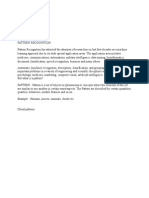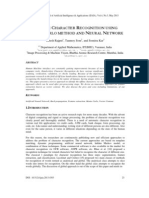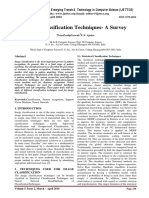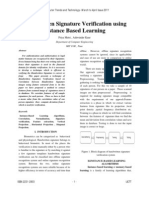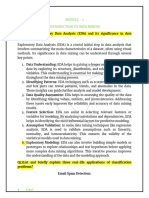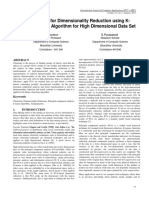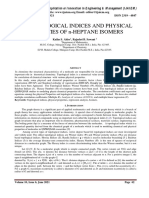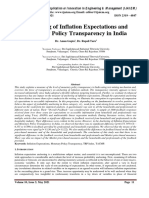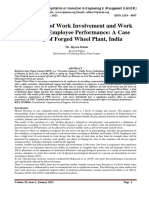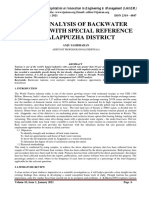An Effective Approach in Face Recognition Using Image Processing Concepts
An Effective Approach in Face Recognition Using Image Processing Concepts
Copyright:
Available Formats
An Effective Approach in Face Recognition Using Image Processing Concepts
An Effective Approach in Face Recognition Using Image Processing Concepts
Original Title
Copyright
Available Formats
Share this document
Did you find this document useful?
Is this content inappropriate?
Copyright:
Available Formats
An Effective Approach in Face Recognition Using Image Processing Concepts
An Effective Approach in Face Recognition Using Image Processing Concepts
Copyright:
Available Formats
International Journal of Application or Innovation in Engineering & Management (IJAIEM)
Web Site: www.ijaiem.org Email: editor@ijaiem.org, editorijaiem@gmail.com Volume 2, Issue 8, August 2013 ISSN 2319 - 4847
An Effective Approach in Face Recognition using Image Processing Concepts
K. Ganapathi Babu1, M.A.Rama Prasad2
2 1 Pursuing M.Tech in CSE at VLITS,Vadlamudi Guntur Dist., A.P., India Asst.Prof, Department of CSE, VLITS,Vadlamudi Guntur Dist., A.P., India
Abstract
Image processing plays a vital role in aspects of all science and technology. In this image processing concepts have great importance in application oriented research and projects. In this face recognition related concepts like authentication, security etc has keen importance. In this we discuss various forms of face recognition using Image processing concepts.
Keywords: face recognition, Image processing, feature extraction
1. INTRODUCTION
When In this face recognition[1] concept we discuss various face recognition techniques and various image processing concepts[8]. In this we discuss different approaches in face recognition and various concepts used in face recognition. In this discus about good approaches in face recognition. In this Eigen faces, discrete cosine transform, filtering, classification ,feature extraction for face recognition. In this we take data sets and apply similarity and classification and then eigen faces calculation and filters and wavelet transforms for face recognition in an effective way.
2.BACKGROUND WORK
Feature extraction[4]: When the input data to an algorithm is too large to be processed and it is suspected to be notoriously redundant then the input data will be transformed into a reduced representation set of features. Transforming the input data into the set of features is called feature extraction. If the features extracted are carefully chosen it is expected that the features set will extract the relevant information from the input data in order to perform the desired task using this reduced representation instead of the full size input. Image processing[8]: image processing is which the input is an image, such as a photo or video the output of image processing possibly will either be an image or a set of characteristics or parameters connected to the image. Image processing regularly refers to digital image processing, except optical and analog image processing also are likely. Pattern recognition[9]: pattern recognition is the task of a label to a given input value. An illustration of pattern recognition is classification[4], which attempts to allot each input value to one of. but, pattern recognition is a additional common problem that encompasses other types of output as well. Other illustration are regression[8], which assigns a real-valued output to each input; succession labeling, which assigns a class to each member of a sequence of values and parsing, which assigns a parse tree to an input sentence, telling the syntactic structure of the sentence. Face recognition: A facial recognition system[9] is a computer application for mechanically identifying or confirming a person from a digital image or a video frame from a video source. One of the behavior to do this is by comparing selected facial features from the image and a facial database. It is classically used in security systems and can be compared to other biometrics such as fingerprint or eye iris recognition systems. Dynamic link matching[4]: Dynamic link matching is a neuronal model for face recognition. It employs wavelet transformations to encode incoming image data. Bunch graph matching is an algorithm stand on many ideas found in dynamic link matching MSL[4]: Multilinear subspace learning (MSL) plans to study a precise little part of a large space of multidimensional objects having a picky desired property. It is a dimensionality reduction approach for decision a low-dimensional representation
Volume 2, Issue 8, August 2013
Page 215
International Journal of Application or Innovation in Engineering & Management (IJAIEM)
Web Site: www.ijaiem.org Email: editor@ijaiem.org, editorijaiem@gmail.com Volume 2, Issue 8, August 2013 ISSN 2319 - 4847
with certain favorite characteristics of high-dimensional tensor data in the course of direct mapping , without going through vectorization[2].The term tensor in MSL refers to multidimensional arrays. illustrations of tensor data include images(2D/3D), video sequences (3D/4D), and hyper spectral cubes(3D/4D). The mapping from a highdimensional tensor space to a low-dimensional tensor space or vector space is named as multilinear projection. HMM[4]: A hidden Markov model (HMM) is a statistical Markov model in which the system individual modeled is assumed to be a Markov process with unobserved states. A HMM can be considered the simplest dynamic Bayesian network[4]. The mathematics behind the HMM was developed by L. E. Baum Elastic matching[4]: Elastic matching is one of the pattern recognition techniques[9] in computer science. Elastic matching (EM) is also known as deformable template, flexible matching, or nonlinear template matching. Elastic matching can be defined as an optimization problem of two-dimensional warping specifying corresponding pixels between subjected images. LDA[8]: Linear discriminant analysis (LDA) and the associated Fisher's linear discriminant are methods worn in statistics, pattern recognition and machine learning to find a linear combination of features which characterizes or separates two or more classes of objects or events. The resulting combination may be used as a linear classifier, or, more frequently, for dimensionality reduction[3] before later classification. PCA[4]: Principal component analysis (PCA) is a mathematical procedure that uses orthogonal transformation to alter a set of observations of maybe correlated variables into a set of values of linearly uncorrelated variables called principal components. The number of principal components is fewer than or equal to the number of original variables. This transformation is defined in such a way that the first principal component has the largest possible and each succeeding component in turn has the highest variance possible under the constraint that it be orthogonal to the previous components. Principal components are guaranteed to be independent if the data set is jointly normally distributed. PCA is sensitive to the relative scaling of the original variables. ICA[5]: independent component analysis (ICA) is a computational method for separating a multivariate signal into additive subcomponents by pretentious that the subcomponents are non-Gaussian signals and that they are all statistically independent of each other. ICA is a special case of blind source separation.
3.RELATED WORK
Eigen values &eigen vectors[8]: An eigenvector of a square matrix is a non-zero vector that, when the matrix is multiplied by , yields a constant multiple of , the multiplier being commonly denoted by . That is: The number is called the eigenvalue of corresponding to
Eigen face[4]: Eigenfaces are a set of eigenvectors used in the computer vision problem of human face recognition. The loom of using eigenfaces for recognition was developed by Sirovich and Kirby (1987) and used by Matthew Turk and Alex Pentland in face classification. It is considered the first flourishing example of facial recognition technology.These eigenvectors are derived from the covariance matrix of the probability distribution of the high-dimensional vector space of likely faces of human beings. DCT: A discrete cosine transform (DCT)[8] expresses a finite series of data points in terms of a sum of cosine functions oscillating at different frequencies. DCTs are significant to numerous applications in science and engineering, from lossy compression of audio and images to spectral methods for the numerical solution of partial differential equations. The use of cosine rather than sine functions is critical in these applications: for compression, it turns out that cosine functions are much more efficient whereas for differential equations the cosines state a particular option of boundary conditions. LSA[4]:
Volume 2, Issue 8, August 2013
Page 216
International Journal of Application or Innovation in Engineering & Management (IJAIEM)
Web Site: www.ijaiem.org Email: editor@ijaiem.org, editorijaiem@gmail.com Volume 2, Issue 8, August 2013 ISSN 2319 - 4847
Latent semantic analysis (LSA) is a technique in natural language processing, in exacting in vectorial semantics, of analyzing relationships between a set of documents and the terms they enclose by producing a set of concepts related to the documents and terms. LSA assumes that words that are close in meaning will occur in similar pieces of text. A matrix containing word counts per paragraph is constructed from a large piece of text and a mathematical technique called singular value decomposition (SVD) is used to lessen the number of columns while preserving the likeness structure among rows. Words are then compared by taking the cosine of the angle between the two vectors produced by any two rows. Values close to 1 represent very similar words while values close to 0 represent very dissimilar words. Bhatta charyya distance[4] : In statistics, the Bhattacharyya distance measures the similarity of two discrete or continuous probability distributions. It is very much related to the Bhattacharyya coefficient which is a measure of the amount of overlap between two statistial samples or populations The coefficient can be used to determine the relative closeness of the two samples being measured. It is used to measure the separability of classes in classification and it is considered to be further reliable than the Mahalanobis distance[4], as the Mahalanobis distance is a particular case of the Bhattacharyya distance when the standard deviations of the two classes is the same. Therefore, when two classes have the similar means but different standard deviations, the Mahalanobis distance would tend to zero, however, the Bhattacharyya distance would grow depending on the difference between the standard deviations. Formula definition: For discrete probability distributions p and q over the same domain X, it is defined as: where: (1)
is the Bhattacharyya coefficient. For continuous probability distributions, the Bhattacharyya coefficient is defined as: In either case, and . doesnt obey the triangle inequality, but the Hellinger distance does obey the triangle inequality. In its simplest formulation, the Bhattacharyya distance between two classes under the normal distribution can be calculated [2] by extracting the mean and variances of two separate distributions or classes: (2) where: is the Bhattacharyya distance between p and q distributions or classes is the variance of the p-th distribution, is the mean of the p-th distribution, and are two different distributions.
4. EFFECTIVE WORK
Face recognition: 1. In this feature extraction features like face, eyes, nose, expressions. 2. Calculation based on Eigen faces by Eigen vector , Eigen values etc. 3. Calculation based on similarity measures for similarity by applying distance measures[6] 4. Classification for differentiating between the images. 5. Image processing concepts like discrete wavelet transform, etc. 6. Applying filters & image processing techniques. 7. Face recognition result of faces used for security, authentication.
Figure 1 Face recognition processing
Volume 2, Issue 8, August 2013
Page 217
International Journal of Application or Innovation in Engineering & Management (IJAIEM)
Web Site: www.ijaiem.org Email: editor@ijaiem.org, editorijaiem@gmail.com Volume 2, Issue 8, August 2013 ISSN 2319 - 4847
In this process of face recognition we perform many process and get result .In this we take our own images and then apply the eigen calculation in this eigen vector,eigen values ,eigen faces calculations [7]are done then similarity matching by using distance measure calculation like manhattan distance etc.then classification for differentiating between the images and wavelet transform and filters like gausian filters[6] and other image processing techniques like shadow removal brightness, contrast etc and then finally we recognize the faces. This process can be done reverse and in any order we get results of face recognition.
5. RESULTS
Comparison of various image processing face recognition concepts. Input image of a mean image for all face recognition using image processing concepts.
Figure 2 Input Mean images for Face recognition processing FaceRecognition using Eigenfaces. Utilizes the two dimensional global grayscale images representing distinctive characteristics
Figure 3 Face recognition processing using Eigen faces Face recognition using gaussian filters
Figure 4 Face recognition processing using Gaussian Filter In above image processing concepts of face recognition eigenfaces is the best for face recognition with good results.
REFERENCES
[1] X. Tang and X. Wang, Face Sketch Recognition, IEEE Trans. Circuits and Systems for Video Technology, vol. 14, no. 1, pp. 50-57, Jan. 2004.
Volume 2, Issue 8, August 2013
Page 218
International Journal of Application or Innovation in Engineering & Management (IJAIEM)
Web Site: www.ijaiem.org Email: editor@ijaiem.org, editorijaiem@gmail.com Volume 2, Issue 8, August 2013 ISSN 2319 - 4847
[2] L. Juwei, K. Plataniotis, and A. Venetsanopoulos, Face Recognition Using Kernel Direct Discriminant Analysis Algorithms, IEEE Trans. Neural Networks, vol. 14, no. 1, pp. 117-126, Jan. 2003. [3] K.I. Kim, K. Jung, and H.J. Kim, Face Recognition Using Kernel Principal Component Analysis, IEEE Signal Processing Letters, vol. 9, no. 2, pp. 40-42, Feb. 2002. [4] http://www.wikipedia.com [5] Y. Hu, A.S. Mian, and R. Owens, Sparse Approximated Nearest Points for Image Set Classification, Proc. IEEE Intl Conf. Computer Vision and Pattern Recognition, 2011. [6] J. Weng, C.H. Evans, and W.S. Hwang, An Incremental Learning Method for Face Recognition under Continuous Video Stream,Proc. IEEE Intl Conf. Automatic Face and Gesture Recognition, pp. 251-256, 2000. [7] X. Li, K. Fukui, and N. Zheng, Image-Set Based Face Recognition Using Boosted Global and Local Principal Angles, Proc. AsianConf. Computer Vision, pp. 323-332, 2009. [8] Digital Image Processing Second Edition Rafael C. Gonzalez University of Tennessee, Prentice Hall Upper Saddle River, New Jersey 07458. [9] Image Processing and Pattern Recognition: Fundamentals and Techniques,Frank Y. Shih,wiley.
AUTHOR PROFILES
K.Ganapathi Babu, pursuing M.Tech in Computer Science Engineering at Vignan's LARA Institute Of Technology and Science, Vadlamudi, Guntur Dist., A.P., India. His research interest includes Image Processing, Pattern Recognition and Network Security. M.A.Rama Prasad, Asst.Prof, Department of CSE, Vignan's LARA Institute Of Technology & Science, Vadlamudi Guntur Dist., A.P., India. His research interest includes Network Security, Mobile Computing and Image Processing.
Volume 2, Issue 8, August 2013
Page 219
You might also like
- RFN14IFG Red Flag Nellis 2014Document79 pagesRFN14IFG Red Flag Nellis 2014Ok FrogNo ratings yet
- Internship Report: Noman DilberDocument42 pagesInternship Report: Noman Dilberfarhan9125No ratings yet
- A Face Recognition Scheme Based On Principle Component Analysis and Wavelet DecompositionDocument5 pagesA Face Recognition Scheme Based On Principle Component Analysis and Wavelet DecompositionInternational Organization of Scientific Research (IOSR)No ratings yet
- Pattern RecognitionDocument57 pagesPattern RecognitionTapasKumarDashNo ratings yet
- Ijaia 040303Document16 pagesIjaia 040303Adam HansenNo ratings yet
- c59bdb5e03d5127d2a02c7939b0c5257Document9 pagesc59bdb5e03d5127d2a02c7939b0c5257mbilal00147No ratings yet
- An Overview of Advances of Pattern Recognition Systems in Computer VisionDocument27 pagesAn Overview of Advances of Pattern Recognition Systems in Computer VisionHoang LMNo ratings yet
- Compression Based Face Recognition Using DWT and SVMDocument18 pagesCompression Based Face Recognition Using DWT and SVMsipijNo ratings yet
- Project ReportDocument62 pagesProject ReportPulkit ChauhanNo ratings yet
- Aravind 500195259 Async AssignmentDocument5 pagesAravind 500195259 Async AssignmentAravind Kumar ReddyNo ratings yet
- A Review of Pattern Recognition TechniquesDocument4 pagesA Review of Pattern Recognition TechniquesijeteeditorNo ratings yet
- Ijecet: International Journal of Electronics and Communication Engineering & Technology (Ijecet)Document6 pagesIjecet: International Journal of Electronics and Communication Engineering & Technology (Ijecet)IAEME PublicationNo ratings yet
- Numeral Recognition Using Statistical Methods Comparison StudyDocument9 pagesNumeral Recognition Using Statistical Methods Comparison Studysar0000No ratings yet
- Ieee Conference Paper TemplateDocument4 pagesIeee Conference Paper TemplateMati ur rahman khanNo ratings yet
- Project ReportDocument35 pagesProject ReportArpit Sharma100% (1)
- Face Recognition Using Linear Discriminant Analysis: Manju Bala, Priti Singh, Mahendra Singh MeenaDocument8 pagesFace Recognition Using Linear Discriminant Analysis: Manju Bala, Priti Singh, Mahendra Singh MeenaAbid BadshahNo ratings yet
- Improved Approach For Logo Detection and RecognitionDocument5 pagesImproved Approach For Logo Detection and RecognitionInternational Journal of Application or Innovation in Engineering & ManagementNo ratings yet
- DL DL2 DL3 MergedDocument11 pagesDL DL2 DL3 MergedHarsh KumarNo ratings yet
- Study On Advancement in Face Recognition Technology: Arpit Arora, Abhishek KR - Rai, DR - Leena AryaDocument4 pagesStudy On Advancement in Face Recognition Technology: Arpit Arora, Abhishek KR - Rai, DR - Leena AryaRavindra KumarNo ratings yet
- Signature Verification Entailing Principal Component Analysis As A Feature ExtractorDocument5 pagesSignature Verification Entailing Principal Component Analysis As A Feature Extractorscience2222No ratings yet
- AI Unit-5 NotesDocument25 pagesAI Unit-5 NotesRajeev SahaniNo ratings yet
- Object Detection Using Machine Learning and Deep LearningDocument6 pagesObject Detection Using Machine Learning and Deep LearningIJRASETPublicationsNo ratings yet
- 05 Linear Algebra and Machine LearningDocument24 pages05 Linear Algebra and Machine LearningLily Cruz0% (1)
- A Secured Template Based Face Recognition TechniqueDocument14 pagesA Secured Template Based Face Recognition TechniqueCS & ITNo ratings yet
- Image Classification Techniques-A SurveyDocument4 pagesImage Classification Techniques-A SurveyInternational Journal of Application or Innovation in Engineering & ManagementNo ratings yet
- Comparative Analysis of Pattern Recognition Methods: An OverviewDocument6 pagesComparative Analysis of Pattern Recognition Methods: An OverviewksumitkapoorNo ratings yet
- A Generalized Matrix Profile Framework With Support For Contextual Series PDFDocument12 pagesA Generalized Matrix Profile Framework With Support For Contextual Series PDFaff kimNo ratings yet
- An Object Recognizing System For Industrial Applications: Marcelo Kleber FelisbertoDocument10 pagesAn Object Recognizing System For Industrial Applications: Marcelo Kleber FelisbertoMarcelo Kleber FelisbertoNo ratings yet
- One-Dimensional Vector Based PatternDocument12 pagesOne-Dimensional Vector Based PatternAnonymous Gl4IRRjzNNo ratings yet
- .Machine Learning Algorithms Trends, Perspectives and ProspectsDocument8 pages.Machine Learning Algorithms Trends, Perspectives and ProspectsArnob TanjimNo ratings yet
- Handwritten Signature Verification Using Instance Based LearningDocument4 pagesHandwritten Signature Verification Using Instance Based Learningsurendiran123No ratings yet
- Online Handwritten Cursive Word RecognitionDocument40 pagesOnline Handwritten Cursive Word RecognitionkousalyaNo ratings yet
- (1998) - A Survey of Shape Analysis TechniquesDocument46 pages(1998) - A Survey of Shape Analysis TechniquescwdaNo ratings yet
- IJAREEIE Paper TemplateDocument8 pagesIJAREEIE Paper TemplateAntriksh BorkarNo ratings yet
- Edab Module - 1Document20 pagesEdab Module - 1Chirag 17No ratings yet
- Contours in Image ProcessingDocument3 pagesContours in Image ProcessingAadil ShNo ratings yet
- A Novel Approach For Content Retrieval From Recognition AlgorithmDocument5 pagesA Novel Approach For Content Retrieval From Recognition AlgorithmInternational Journal of Application or Innovation in Engineering & ManagementNo ratings yet
- Overviewof Data Mining Techniques and Image SegmentationDocument5 pagesOverviewof Data Mining Techniques and Image SegmentationIntegrated Intelligent ResearchNo ratings yet
- Fast Face Recognition Using Eigen FacesDocument4 pagesFast Face Recognition Using Eigen FacesEditor IJRITCCNo ratings yet
- International Journal of Engineering Research and DevelopmentDocument5 pagesInternational Journal of Engineering Research and DevelopmentIJERDNo ratings yet
- A New Method For Dimensionality Reduction Using K-Means Clustering Algorithm For High Dimensional Data SetDocument6 pagesA New Method For Dimensionality Reduction Using K-Means Clustering Algorithm For High Dimensional Data SetM MediaNo ratings yet
- A Comparative Analysis On Linear Regression and Support Vector RegressionDocument5 pagesA Comparative Analysis On Linear Regression and Support Vector Regressionr.pasalau24No ratings yet
- 1 Ijcseitrfeb20171Document8 pages1 Ijcseitrfeb20171TJPRC PublicationsNo ratings yet
- PPAI PaperDocument9 pagesPPAI PaperMOHAMMED HANZLA HUSSAINNo ratings yet
- Enhancement and Segmentation of Historical RecordsDocument19 pagesEnhancement and Segmentation of Historical RecordsCS & ITNo ratings yet
- Automata Report FormatDocument9 pagesAutomata Report Formatrockmachr23No ratings yet
- Comparative Analysis of Selected FacialDocument9 pagesComparative Analysis of Selected FacialFrengki SimatupangNo ratings yet
- PR Unit 1 ....Document34 pagesPR Unit 1 ....RITIK UPADHYAYNo ratings yet
- Energy Computation Using DCT For Brain Computer Interface Motor Imagery ClassificationDocument4 pagesEnergy Computation Using DCT For Brain Computer Interface Motor Imagery ClassificationchakriNo ratings yet
- Significance of DimensionalityDocument16 pagesSignificance of DimensionalitysipijNo ratings yet
- Image Restoration by Learning Morphological Opening-Closing NetworkDocument21 pagesImage Restoration by Learning Morphological Opening-Closing NetworkMuhammad Awais ShahNo ratings yet
- Pattern RecognitionDocument3 pagesPattern RecognitionSaptadwipa RakshitNo ratings yet
- Think Globally, Fit LocallyDocument33 pagesThink Globally, Fit LocallyAli Umair KhanNo ratings yet
- Journal of Computer Applications - WWW - Jcaksrce.org - Volume 4 Issue 2Document5 pagesJournal of Computer Applications - WWW - Jcaksrce.org - Volume 4 Issue 2Journal of Computer ApplicationsNo ratings yet
- Plantillas Gráficas para El Registro de Modelos.Document12 pagesPlantillas Gráficas para El Registro de Modelos.carlosNo ratings yet
- Research Inventy: International Journal of Engineering and ScienceDocument5 pagesResearch Inventy: International Journal of Engineering and ScienceresearchinventyNo ratings yet
- UNIT-V NotesDocument24 pagesUNIT-V Notesmishrashlok888No ratings yet
- Manisha Satone 2014Document14 pagesManisha Satone 2014Neeraj KannaugiyaNo ratings yet
- An Efficient Method K-Means Clustering For Detection of Tumour Volume in Brain MRI ScansDocument10 pagesAn Efficient Method K-Means Clustering For Detection of Tumour Volume in Brain MRI ScansEditor IJTSRDNo ratings yet
- Contextual Image Classification: Understanding Visual Data for Effective ClassificationFrom EverandContextual Image Classification: Understanding Visual Data for Effective ClassificationNo ratings yet
- Python Machine Learning for Beginners: Unsupervised Learning, Clustering, and Dimensionality Reduction. Part 1From EverandPython Machine Learning for Beginners: Unsupervised Learning, Clustering, and Dimensionality Reduction. Part 1No ratings yet
- THE TOPOLOGICAL INDICES AND PHYSICAL PROPERTIES OF n-HEPTANE ISOMERSDocument7 pagesTHE TOPOLOGICAL INDICES AND PHYSICAL PROPERTIES OF n-HEPTANE ISOMERSInternational Journal of Application or Innovation in Engineering & ManagementNo ratings yet
- Detection of Malicious Web Contents Using Machine and Deep Learning ApproachesDocument6 pagesDetection of Malicious Web Contents Using Machine and Deep Learning ApproachesInternational Journal of Application or Innovation in Engineering & ManagementNo ratings yet
- Study of Customer Experience and Uses of Uber Cab Services in MumbaiDocument12 pagesStudy of Customer Experience and Uses of Uber Cab Services in MumbaiInternational Journal of Application or Innovation in Engineering & ManagementNo ratings yet
- An Importance and Advancement of QSAR Parameters in Modern Drug Design: A ReviewDocument9 pagesAn Importance and Advancement of QSAR Parameters in Modern Drug Design: A ReviewInternational Journal of Application or Innovation in Engineering & ManagementNo ratings yet
- Study of Customer Experience and Uses of Uber Cab Services in MumbaiDocument12 pagesStudy of Customer Experience and Uses of Uber Cab Services in MumbaiInternational Journal of Application or Innovation in Engineering & ManagementNo ratings yet
- Soil Stabilization of Road by Using Spent WashDocument7 pagesSoil Stabilization of Road by Using Spent WashInternational Journal of Application or Innovation in Engineering & ManagementNo ratings yet
- Analysis of Product Reliability Using Failure Mode Effect Critical Analysis (FMECA) - Case StudyDocument6 pagesAnalysis of Product Reliability Using Failure Mode Effect Critical Analysis (FMECA) - Case StudyInternational Journal of Application or Innovation in Engineering & ManagementNo ratings yet
- An Importance and Advancement of QSAR Parameters in Modern Drug Design: A ReviewDocument9 pagesAn Importance and Advancement of QSAR Parameters in Modern Drug Design: A ReviewInternational Journal of Application or Innovation in Engineering & ManagementNo ratings yet
- The Mexican Innovation System: A System's Dynamics PerspectiveDocument12 pagesThe Mexican Innovation System: A System's Dynamics PerspectiveInternational Journal of Application or Innovation in Engineering & ManagementNo ratings yet
- A Deep Learning Based Assistant For The Visually ImpairedDocument11 pagesA Deep Learning Based Assistant For The Visually ImpairedInternational Journal of Application or Innovation in Engineering & ManagementNo ratings yet
- Design and Detection of Fruits and Vegetable Spoiled Detetction SystemDocument8 pagesDesign and Detection of Fruits and Vegetable Spoiled Detetction SystemInternational Journal of Application or Innovation in Engineering & ManagementNo ratings yet
- Performance of Short Transmission Line Using Mathematical MethodDocument8 pagesPerformance of Short Transmission Line Using Mathematical MethodInternational Journal of Application or Innovation in Engineering & ManagementNo ratings yet
- A Comparative Analysis of Two Biggest Upi Paymentapps: Bhim and Google Pay (Tez)Document10 pagesA Comparative Analysis of Two Biggest Upi Paymentapps: Bhim and Google Pay (Tez)International Journal of Application or Innovation in Engineering & ManagementNo ratings yet
- Staycation As A Marketing Tool For Survival Post Covid-19 in Five Star Hotels in Pune CityDocument10 pagesStaycation As A Marketing Tool For Survival Post Covid-19 in Five Star Hotels in Pune CityInternational Journal of Application or Innovation in Engineering & ManagementNo ratings yet
- Anchoring of Inflation Expectations and Monetary Policy Transparency in IndiaDocument9 pagesAnchoring of Inflation Expectations and Monetary Policy Transparency in IndiaInternational Journal of Application or Innovation in Engineering & ManagementNo ratings yet
- The Impact of Effective Communication To Enhance Management SkillsDocument6 pagesThe Impact of Effective Communication To Enhance Management SkillsInternational Journal of Application or Innovation in Engineering & ManagementNo ratings yet
- Design and Manufacturing of 6V 120ah Battery Container Mould For Train Lighting ApplicationDocument13 pagesDesign and Manufacturing of 6V 120ah Battery Container Mould For Train Lighting ApplicationInternational Journal of Application or Innovation in Engineering & ManagementNo ratings yet
- Impact of Covid-19 On Employment Opportunities For Fresh Graduates in Hospitality &tourism IndustryDocument8 pagesImpact of Covid-19 On Employment Opportunities For Fresh Graduates in Hospitality &tourism IndustryInternational Journal of Application or Innovation in Engineering & ManagementNo ratings yet
- Ijaiem 2021 01 28 6Document9 pagesIjaiem 2021 01 28 6International Journal of Application or Innovation in Engineering & ManagementNo ratings yet
- The Effect of Work Involvement and Work Stress On Employee Performance: A Case Study of Forged Wheel Plant, IndiaDocument5 pagesThe Effect of Work Involvement and Work Stress On Employee Performance: A Case Study of Forged Wheel Plant, IndiaInternational Journal of Application or Innovation in Engineering & ManagementNo ratings yet
- Swot Analysis of Backwater Tourism With Special Reference To Alappuzha DistrictDocument5 pagesSwot Analysis of Backwater Tourism With Special Reference To Alappuzha DistrictInternational Journal of Application or Innovation in Engineering & ManagementNo ratings yet
- Application of Mersey Silt As Fine Aggregate in ConcreteDocument9 pagesApplication of Mersey Silt As Fine Aggregate in ConcreteInternational Journal of Application or Innovation in Engineering & ManagementNo ratings yet
- Analysis of RCC Beam Using GFRP Wrapped With Cellular StirrupsDocument11 pagesAnalysis of RCC Beam Using GFRP Wrapped With Cellular StirrupsInternational Journal of Application or Innovation in Engineering & ManagementNo ratings yet
- Marco Economic Sustainability in India: Partisan Theory ApproachDocument7 pagesMarco Economic Sustainability in India: Partisan Theory ApproachInternational Journal of Application or Innovation in Engineering & ManagementNo ratings yet
- Chapter 12 MKTG6Document28 pagesChapter 12 MKTG6Angela StephenNo ratings yet
- Useful WebsitesDocument4 pagesUseful WebsitesAimal KhanNo ratings yet
- Algorithm Pseudocode FlowchartsDocument32 pagesAlgorithm Pseudocode FlowchartsAvinash kumarNo ratings yet
- Using Quality Tools and Techniques SuccessfullyDocument7 pagesUsing Quality Tools and Techniques SuccessfullyYokoyoko2011No ratings yet
- 102.20-N1 (1109) SolutionDocument140 pages102.20-N1 (1109) Solutionlist16947No ratings yet
- Crompton PumpDocument2 pagesCrompton PumpAbiNo ratings yet
- Jadwal Iht 2023 2024Document2 pagesJadwal Iht 2023 2024nita ferawatiNo ratings yet
- 9) Method Statement For Connection of Proposed Conminedv Waste Water Pipe To Existing Authority Line (Tie in Connec Tion)Document37 pages9) Method Statement For Connection of Proposed Conminedv Waste Water Pipe To Existing Authority Line (Tie in Connec Tion)sandeep reshmaNo ratings yet
- Dannyengineportal - Positive Crankcase VentilationDocument9 pagesDannyengineportal - Positive Crankcase VentilationNay lin AungNo ratings yet
- SAP B1 Preparation GuideDocument10 pagesSAP B1 Preparation GuideSujit DhanukaNo ratings yet
- Human Error in Aviation PDFDocument160 pagesHuman Error in Aviation PDFMani SelvanNo ratings yet
- ECSC SecurityManagementBriefingiPadDocument2 pagesECSC SecurityManagementBriefingiPadSafiya AlbusaidiNo ratings yet
- Td520ge PDFDocument11 pagesTd520ge PDFThanapong Usupan100% (1)
- SDP Assignment UCDF1401 Preview VersionDocument4 pagesSDP Assignment UCDF1401 Preview Version....No ratings yet
- 04.layout Oral PresentationDocument2 pages04.layout Oral PresentationDoni SujanaNo ratings yet
- Olympus SP-720UZ Instruction ManualDocument76 pagesOlympus SP-720UZ Instruction ManualnaimenimNo ratings yet
- The Effects of Limestone Characteristics and Calcination Temperature On The Reactivity of QuicklimeDocument8 pagesThe Effects of Limestone Characteristics and Calcination Temperature On The Reactivity of QuicklimeFermanton SiagianNo ratings yet
- 1 BBN PDFDocument15 pages1 BBN PDFBeny StephenNo ratings yet
- Basic Principles of Design and LayoutDocument4 pagesBasic Principles of Design and LayoutStan talent, stan BTOBNo ratings yet
- The Study of The Effect of Altering The Vertical Dimension of Occlusion On The Magnitude of Biting ForceDocument6 pagesThe Study of The Effect of Altering The Vertical Dimension of Occlusion On The Magnitude of Biting ForceMuthia HannisaNo ratings yet
- Digital Thermostat Module Model XH-W1209 Manufacturer-Supplier ChinaDocument5 pagesDigital Thermostat Module Model XH-W1209 Manufacturer-Supplier ChinaDaniel TruccoNo ratings yet
- Vivo (Technology Company) : HistoryDocument6 pagesVivo (Technology Company) : HistoryanandhuNo ratings yet
- Jean-Marie Tjibaou Cultural Centre: Master Student: Sarah Omran L 11800199Document21 pagesJean-Marie Tjibaou Cultural Centre: Master Student: Sarah Omran L 11800199sarahNo ratings yet
- EF1A Money Barter To BitcoinsDocument12 pagesEF1A Money Barter To BitcoinsMadhu SrivastavaNo ratings yet
- 850BDocument0 pages850BAjay AjayNo ratings yet
- 2014 Monthly CalendarDocument12 pages2014 Monthly CalendarBansboyNo ratings yet
- Structural Drafting Structural Symbols and Conventions GeneralDocument10 pagesStructural Drafting Structural Symbols and Conventions GeneralKirti DuttNo ratings yet
- Used Water SES 7 Testing 12feb2016Document9 pagesUsed Water SES 7 Testing 12feb2016Mark BenjieNo ratings yet



